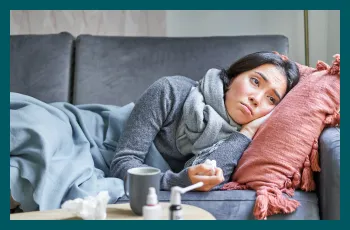Illnesses that cause flu-like symptoms
Written by Dr Nelson Lau, MBBS FRACGP, GP & Digital Health Specialist. Originally published on 15 November 2024. Blog updated on 19 September,2025.

Contents

Overview
Influenza (the flu) is a viral illness that spreads widely in Australia, especially during winter. Each year, thousands of Aussies are diagnosed with the flu, with over 200,000 cases reported to the National Notifiable Diseases Surveillance System in 2023. While many recover at home, or through a treatment from a telehealth doctor the flu can be serious for older adults, children, and those with chronic health conditions.What is influenza (the flu)?
The flu is a contagious respiratory infection caused by influenza viruses. It spreads through coughing, sneezing, and close contact, and often comes on suddenly. Unlike the common cold, the flu usually causes stronger symptoms and can lead to complications.Common Symptoms of the Flu
- Fever and chills – Often sudden, with temperatures rising quickly
- Cough (dry or chesty) – Persistent and can last longer than other symptoms
- Sore throat – Often severe and paired with a cough
- Runny or blocked nose – Sometimes mistaken for a cold, but paired with more severe fatigue
- Headaches – Can be intense and worsen with fever
- Muscle aches and joint pain – Common and make it hard to move around
- Extreme tiredness – Fatigue that lingers even after other symptoms ease
- Loss of appetite – Many people struggle to eat during the illness
Illnesses that can cause flu-like symptoms
Certain illnesses have similar symptoms to the flu, making diagnosis challenging without testing. Here are five common conditions that may cause flu-like symptoms:COVID-19:
COVID-19, caused by the SARS-CoV-2 virus, shares symptoms with the flu, such as fever, chills, body aches, and fatigue. However, COVID-19 often includes unique symptoms like loss of taste or smell, which rarely occur with the flu. COVID can also cause prolonged symptoms (known as “long COVID”) that persist even after recovery from the acute phase.Mononucleosis (Mono):
Also called “the kissing disease,” or Glandular Fever, mono is caused by the Epstein-Barr virus. It produces flu-like symptoms, including fatigue, sore throat, and swollen lymph nodes, but fever in mono is often less intense and can last longer. Mono typically also causes extreme fatigue that may persist for weeks or even months.Strep throat:
Strep throat, a bacterial infection, can cause fever, sore throat, and swollen lymph nodes. While body aches are less common, people with strep throat often experience throat pain, difficulty swallowing, and white patches in the throat. Unlike viral illnesses, strep requires antibiotics for effective treatment.Pneumonia:
Pneumonia, an infection of the lungs, can present flu-like symptoms, including fever, chills, fatigue, and body aches. Unlike the flu, pneumonia may also cause shortness of breath, chest pain, and a persistent, sometimes productive cough.Experiencing these symptoms? Speak with a doctor within 15 minutes.
See a Doctor now
Available 24/7, across Australia.
How can you tell if you have the flu, COVID, or another illness?
Flu, COVID-19, and other infections share common symptoms, making it difficult to differentiate them without medical testing. Here are a few distinctions:- Symptom duration: The flu generally lasts 1-2 weeks, while COVID-19 symptoms may extend or recur due to long COVID.
- Unique symptoms: Loss of taste or smell is more characteristic of COVID-19, while a sore throat with visible white patches is typical of strep throat.
- Physical signs: Conditions like the flu may present with a runny nose and cough, whereas mono often leads to prolonged fatigue and swollen lymph nodes.
What tests can diagnose flu-like illnesses?
Several tests are available to confirm the cause of flu-like symptoms:- Rapid flu test: A swab test that provides quick results for influenza.
- COVID-19 test: PCR or antigen tests can detect COVID-19. These are available at healthcare facilities, pharmacies, and for at-home use.
- Monospot test: A blood test used to diagnose mono.
- Strep test: A rapid test or throat culture can confirm strep throat.
- Blood tests and imaging: For conditions like pneumonia, blood tests and chest X-rays may be necessary for accurate diagnosis.
How are flu-like symptoms treated?
Treating flu-like symptoms depends on the underlying cause, but general supportive care includes:- Rest and hydration: Adequate rest and fluid intake support immune function and recovery.
- Over-the-counter medications: Medications like paracetamol or ibuprofen can reduce fever and body aches. Decongestants or cough suppressants may relieve other symptoms.
- Antivirals or antibiotics: Prescription antivirals are available for the flu, while antibiotics treat bacterial infections like strep throat.
- Hydration and nutrition: Proper hydration is vital, especially for illnesses with fever, to prevent dehydration.
Self-care & home management
- Rest – Your body needs energy to fight the virus
- Stay hydrated – Drink plenty of water, soups, or herbal teas
- Use over-the-counter relief – Paracetamol or ibuprofen may ease fever and aches
- Soothing remedies – Saltwater gargles or lozenges for sore throat
- Stay home – Prevent spreading the flu to others by avoiding school or work
Can flu-like symptoms be prevented?
There are preventive measures to reduce the risk of contracting flu-like illnesses:- Vaccination: Annual flu shots and COVID-19 vaccinations significantly reduce the risk of severe illness.
- Hygiene practices: Frequent handwashing, using sanitiser, and avoiding touching your face can prevent the spread of germs.
- Avoiding sick contacts: Avoid close contact with those who are ill, especially during flu season.
- Healthy lifestyle: Maintaining a balanced diet, getting regular exercise, and managing stress support a strong immune system.
When to see a doctor via Hola Health telehealth
Telehealth services offer a convenient option for managing flu-like symptoms from home. Here’s when telehealth is a suitable choice:- Mild symptoms: If symptoms are mild and manageable, a online doctor consultation can provide advice and potential prescriptions.
- Need for symptom relief: A telehealth provider can suggest over-the-counter remedies or prescribe medications to ease symptoms.
- Monitoring chronic conditions: If you have a chronic condition (like asthma or diabetes) and develop flu-like symptoms, a telehealth consultation can help monitor your health.
- Medical documentation needs: When you need an online medical certificate or GP referrals.
FAQs
What are the first signs of the flu?
Sudden fever, chills, and body aches are usually the first signs. Many people also feel very tired at the start.How can I tell the difference between a cold and the flu?
Colds tend to be milder with runny noses and sneezing. The flu usually hits harder, with fever, fatigue, and body aches.Can you have the flu without a cough?
Yes, some people mainly get fever, fatigue, and aches without a cough. But most people will develop one at some stage.How long do flu symptoms last in adults?
Flu symptoms usually last 5–7 days, but tiredness can stick around for 1–2 weeks. Recovery time varies by person.Can I get a medical certificate online for the flu in Australia?
Yes, telehealth services and platforms like Hola Health can provide medical certificates after an online doctor’s review. This saves you a trip when you’re unwell.Does the flu always cause a high fever?
No, while fever is common, not everyone experiences it. Some people mainly get tiredness, aches, and cough.How long is the flu contagious in Australia?
Most people are contagious from 1 day before symptoms to about 7 days after. Children and those with weaker immune systems may spread it longer.What is the medical care & treatment options for flu?
Doctors may prescribe medications in certain cases, especially if started within the first 48 hours. These can shorten illness duration and reduce severity. Hospital care may be needed for severe cases, particularly in vulnerable groups.How to prevent the flu in Australia
The best protection is the annual flu vaccine, recommended for everyone over 6 months old. Good hygiene—washing hands, covering coughs, and staying home when sick—also helps reduce spread. Public health campaigns across Australia encourage vaccination each winter to protect communities.When to consult a doctor in Australia
See your GP if your symptoms are severe, not improving after a week, or you’re at higher risk (pregnant, elderly, or with chronic illness). Seek urgent medical help if you have difficulty breathing, chest pain, or sudden dizziness.Need time off to recover? Get your medical certificate online within 15 minutes.
Request a medical certificate
Available 24/7, across Australia.
What we treat
- Cough
- Nausea & vomiting
- Fever
- Hayfever
- Fatigue
- Sore throat
- Acne
- Hair loss
- Gout
- Eczema
- Rosacea
- Sunburn
- UTI
- Erectile dysfunction
- Contraception
- Morning sickness
- Morning after pill
- Prostate health
- Anxiety
- Depression
- Stress
- Grief & loss
- Antidepressants
- Premature ejaculation
- Asthma
- Blood pressure
- Blood thinners
- Diabetes
- Cholesterol
- Migraines & headaches
- Allergies
- Body ache
- Heartburn & reflux
- Sleep disorder
- Pain relief
- Gastro
Related Articles
Disclaimer
This blog is for general informational purposes only and does not indicate that Hola Health provides all treatments or preventive measures mentioned. It is not intended to be a substitute for professional medical advice. Always seek the guidance of your doctor or other qualified health professional with any questions you may have regarding your health or a medical condition. For emergencies please immediately contact 000. Any medical topics discussed are intended to educate, not to imply availability through Hola Health.
 Facebook
Facebook  X
X  Copy Link
Copy Link



